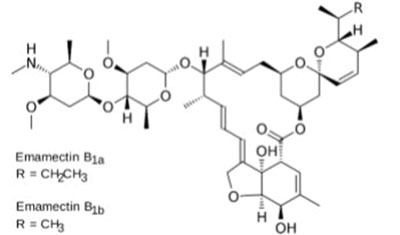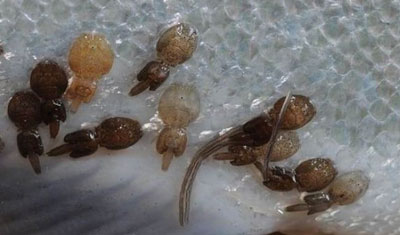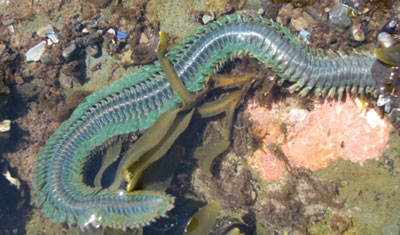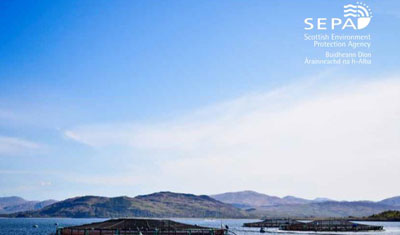
Chemical structure of emamectin benzoate © WFDUK[2]
SLICE®, a treatment for parasitic sea lice on salmon, is widely used by Scottish salmon farms in open net pens, despite documented impacts on neighbouring marine wildlife. The active ingredient in SLICE®, emamectin benzoate (EMB) is toxic to mammals, birds, fish, invertebrates, crustaceans and aquatic plants [1]. With the Scottish Government and industry advocating a growth in salmon farming can our lochs and wildlife cope with the inevitable increase in SLICE® use? If a farm has persistent problems with lice and is reliant on harmful treatments to manage infestations, it should be questioned whether that farm is viable and sustainable into the future.
The sea lice problem
Sea lice are a significant challenge for salmon farms. The lice live on the surface of the fish and feed on its skin, which in severe cases results in open wounds leading to secondary infections and problems regulating the balance of bodily fluids through their skin and kidneys. Infection may make the fish more susceptible to other diseases and could ultimately contribute to the loss of salmon stock. Young salmon are not infected by sea lice as they hatch and live their early life in freshwater, however once transferred to open sea pens at their late juvenile (smolt) stage and as adults they then get infected by sea lice from waters and wild fish around the farm. The confined environment of the pens allows sea lice infestations to proliferate to significantly high numbers which put salmon at risk.
The use of the medicine SLICE® grew dramatically after it was introduced to the market in 2000 and it is now widely used in Scotland and around the globe[3]. In Scotland it is used for the treatment and control of infections by two species of sea lice, the Salmon louse (Lepeophtheirus salmonis ) and Sea louse (Caligus elongatus ), on Atlantic salmon (Salmo salar L.).

The salmon louse (Lepeophtheirus salmonis © Sea Lice Research Centre
EMB build-up in the environment
Of the chemicals used to treat sea lice, SLICE® is the only treatment currently used in feed in Scotland, with other chemicals used in bath treatments[4]. EMB gets into the environment through uneaten food and fish faeces. It can then remain in the sediment underneath, and the water around, salmon farm cages [5].
The application of SLICE® is regulated by the Scottish Environment Protection Agency (SEPA), and Controlled Activity Regulations (CAR) licenses[6]. These licenses set out how much EMB can be used and allowed in the environment. These limits are based on models which predict the dispersion of chemicals, and Environmental Quality Standards (EQS) for individual chemicals derived from laboratory toxicity testing[7]. An EQS sets the ratio of pollutant allowed in a water environment. There is a “far-field” sediment EQS Maximum Acceptable Concentration (MAC) for the protection of all marine life more than 25m from the marine cages and a “near-field” MAC trigger value for monitoring sediment within 25 m of marine cages. There is also an EQS-MAC for the water body immediately around the farm.
No fines for license breaches
While there are actions required by farms that breach their CAR license conditions, there are no fines for initial breaches, with the first requirement being to stop using the chemical, or use less[8]. It begs the question that if breaches were routinely fined, would that influence industry to monitor its discharges more stringently to avoid breaches in the first place, and potentially use less SLICE® in order to limit the risks of breaching their license?
Persistence of EMB can impact marine wildlife
EMB causes paralysis by suppressing muscle contraction, and increasing cell membrane permeability to chloride ions, disrupting physiological processes. It has a high ecotoxicology potential for mammals, birds and aquatic invertebrates, and moderate for fish, aquatic crustaceans and aquatic plants[9].
The presence and persistence in the environment of a biocide such as EMB can create pressures on populations of non-target organisms. Once EMB gets into the sediment it doesn’t break down easily (EMB has a low solubility in sea water and a high potential for adsorption to particles or sediments, with a long half-life of up to 404 days in sediments with little or no oxygen present[10]). Its persistence in sediments and on particles means that scavengers, especially crustaceans, will be most at risk from its effects. Impacts can be more subtle than causing mortality, for example it has been shown to have a significant impact on the clamworm (Nereis virens), causing decreases in worm body mass and marked behavioural changes (lack of burrowing)[11].

Ragworm Nereis spp © ClaudeNozeres (WoRMS)
EMB can build up in organisms that ingest it, as it takes a relatively long time to be excreted from the body. A major concern is the risk to wild organisms, and to humans eating wild-caught seafood. Research on the blue mussel (Mytilus edulis) found EMB to be particularly persistent in mussel tissue, indicating potential impacts on both farmed and wild mussels in areas where EMB is used[12].
Build-up of EMB in salmon flesh
The uptake of EMB by the salmon themselves has the potential for health risks to them and the consumer. A recent study in British Colombia found that 90% of salmon that received a 7-day EMB treatment had concentrations in the muscle at or above the threshold level recommended in the SLICE® Usage Guidelines[13].
The persistence of EMB in the salmon means a maximum residue limit (MRL) exists, which is the maximum level of the chemical allowed in harvested salmon. In Europe fish must not be treated more than once in the 60 days before being harvested for human consumption[14].
Results are available of samples taken from salmon for residues of veterinary medicines. EMB residues were found in 2 out of 96 samples taken in 2012, and 3 out of 91 in 2016. The 2012 EMB residues were determined to be due to a sample being taken during the withdrawal period in one case, with the other case due to the dosage being exceeded, while the 2016 residues were due to excess dosage[15]. Although a very small part of the sample size, this shows there is a risk of residues being present in harvested fish, and indicates that regular sampling on a wide scale for EMB residues should be mandatory.
Resistance to SLICE® is on the increase
Lice are known to be developing resistance to this treatment. This could either be due to over-use of the product, and/or farms applying low doses that are not actually effective, but which enable the build-up of resistance [16]. The long elimination half-life of EMB, whilst potentially offering additional protection, may also increase resistance by staying in the fish at levels below the therapeutic range for a long time.
When does the precautionary principle indicate EMB should be banned?
A 2018 study by SEPA of marine fish farm sites in Shetland found concentrations of EMB were above the then near-field standards at 17% of stations, and above far-field standards at 7% of stations[17]. When compared to lower proposed standards, 100% of near-field stations and 75% of far-field stations had concentrations above standards. This clearly shows that the use of EMB on farms is having significant impacts at and beyond the immediate vicinity of the farm. A peer-reviewed paper of the same study stated that such widespread distribution of EMB in the environment was not observed in other studies to date, and suggested residues of the chemical occur more widely than previously understood[18].
A strong precautionary approach is needed regarding the potential environmental impact of any growth of the sector, either through increasing biomass at present sites, or development of new sites. A moratorium on further expansion should be considered until it can be shown that any growth in the industry will have no adverse environmental impact. We are concerned that the planned increase in production of Atlantic salmon will lead to additional use of EMB. This should be treated with extreme caution, as the low-level effects of long-term usage on benthic and pelagic ecosystem components at the scale of lochs cannot be predicted. There is a reliance on the concept of ‘Assimilative Capacity’, the ability of a body of water to cleanse itself, through its capacity to receive waste waters or toxic substances without harmful effects and without damage to aquatic life. The effectiveness of this at the scale of industrial fish farming, with its associated chemicals and waste, should be closely examined, as it is unlikely to be effective on a large or increased scale.
SEPA’s interim position on EMB and new regulatory standards

Cover page, SEPA: Protection of the Marine Environment; Discharges from marine pen fish farms; A strengthened regulatory framework.
SEPA reassessed the EQS for EMB and imposed new limits in 2017, and subsequently at the end of 2018[19]. However, these limits are only mandatory to new applications or applications to increase the use of EMB. Existing users will be asked to voluntarily reduce usage by 60%. There has been a call for international EQSs after a study of samples from areas around Norwegian fish farms alarmingly found levels of EMB in sediment were higher than the then UK EQS in half the samples tested[20]. With the increasing evidence of the harmful effects of the chemical there is a strong case to go further than this and examine the case for ceasing its use altogether. At the very least consideration should be given to eliminating its use where farms are sited near Marine Protected Areas.
SEPA’s newly published regulatory framework on discharges from marine pen fish farms makes no specific mention of a new approach for controlling the use of EMB[21]. An interim position statement claims the limit is set so low that it will, effectively, mean EMB can only be discharged in very limited quantities at any new site[22]. This seems to contrast strongly with the voluntary actions requested of sites with existing authorisation to use it.
Time to cut the SLICE®
SEPA has asked the UK Technical Advisory Group (UKTAG), a partnership of the UK environment and conservation agencies, to make recommendations on new environmental standards for EMB to the Scottish Government, which will be out for consultation from 24th May to 5th July 2019[23]. The Veterinary Medicines Directorate product information database on SLICE® states that it should not be used for treatment of smolts in freshwater cages due to potential environmental risks[24]. The 2018 study by SEPA concluded that EMB concentration had ‘the single biggest negative effect on both crustacean abundance and species richness’. Surely the review will provide the opportunity to extend this to marine net pens and for the salmon farming industry to cut out SLICE® use?
The impact of removing EMB would be increased innovation around alternative methods, such as mechanical or biological treatments to remove lice and development of lice-resistant strains of salmon. It would also require stringent examination of the present and future siting of farms to ensure their position does not exacerbate lice levels both within farms and in the surrounding marine environment.
Put simply, if a farm cannot survive without the need to use EMB, should it be in production at all?
[1] https://sitem.herts.ac.uk/aeru/bpdb/Reports/1326.htm
[2] https://pubchem.ncbi.nlm.nih.https://www.wfduk.org/sites/default/files/Background%20Report%20-%20CTT%20recommendation%20for%20an%20EQS%20for%20emamectin%20benzoate_0.pdfgov/compound/Emamectin_benzoate#section=Structures
[3] Lees, F. et al (2008) Changes in epidemiological patterns of sea lice infestation on farmed Atlantic salmon (Salmo salar L) in Scotland between 1996 and 2006. Journal of Fish Diseases, 31(4), pp 259-268. https://onlinelibrary.wiley.com/doi/abs/10.1111/j.1365-2761.2007.00897.x
[4] http://www.parliament.scot/S5_Environment/General%20Documents/20180125_SAMS_Review_of_Environmental_Impact_of_Salmon_Farming_-_Report.pdf
[5] Kim-Kang, H. et al. (2004) Tissue distribution, metabolism, and residue depletion study in Atlantic salmon following oral administration of [3H] emamectin benzoate. Journal of agricultural and food chemistry, 52(7), pp 2108-2118. https://pubs.acs.org/doi/abs/10.1021/jf035435v#
[6] https://www.sepa.org.uk/media/114940/fish-farm-manual-attachment-15.pdf
[7] https://www.sepa.org.uk/media/299675/wrc-uc12191-03-review-of-environmental-quality-standard-for-emamectin-benzoate.pdf
[8] https://www.sepa.org.uk/media/114940/fish-farm-manual-attachment-15.pdf
[9] https://sitem.herts.ac.uk/aeru/bpdb/Reports/1326.htm
[10] Benskin, J.P. et al (2018) Biodegradation potential of aquaculture chemotherapeutants in marine sediments. Aquaculture Research, 47, 482-497. https://onlinelibrary.wiley.com/doi/abs/10.1111/are.12509
[11] McBriarty, G.J. et al (2017) Short-Term Effects of the Anti-sea Lice Therapeutant Emamectin Benzoate on Clam Worms (Nereis Virens). Archives of Environmental Contamination and Toxicology, 74(4), pp539-545. https://link.springer.com/article/10.1007%2Fs00244-017-0461-2
[12] Brooks, S.J. et al (2019) Bioaccumulation of selected veterinary medicinal products (VMPs) in the blue mussel (Mytilus edulis). Science of the Total Environment, 655, pp1409-1419. https://www.sciencedirect.com/science/article/pii/S0048969718345686
[13] St-Hilaire, S. et al (2019) Evaluating the concentration of emamectin benzoate in Atlantic salmon tissues after sea lice treatments, Aquaculture, 498, pp464-469. https://www.sciencedirect.com/science/article/pii/S0044848618308184#f0010
[14] https://www.vmd.defra.gov.uk/ProductInformationDatabase/Default.aspx
[15] https://www.gov.uk/government/collections/residues-statutory-and-non-statutory-surveillance-results
[16] Besnier, F. et al (2014) Human-induced evolution caught in action: SNP-array reveals rapid amphi-atlantic spread of pesticide resistance in the salmon ecotoparasite Lepeophtheirus salmonis. BMC Genomics, 19, p937. https://bmcgenomics.biomedcentral.com/articles/10.1186/1471-2164-15-937
[17] SEPA (2018) Fish Farm Survey Report: Evaluation of a new seabed monitoring approach to investigate the impacts of marine cage fish farms. 33pp. https://consultation.sepa.org.uk/sector-plan/finfishaquaculture/supporting_documents/Fish%20Farm%20Survey%20Report.pdf
[18] Bloodworth, J.W. et al (2019) Negative effects of the sea lice therapeutant emamectin benzoate at low
concentrations on benthic communities around Scottish fish farms. Science of the Total Environment, 669, pp 91-102. https://www.sciencedirect.com/science/article/pii/S0048969719309428?via%3Dihub#bb0355
[19] https://www.sepa.org.uk/media/387054/sepa_position_statement_implementation_of_car.pdf
[20] Langford, K.H. et al (2014) Do Antiparasitic Medicines Used in Aquaculture Pose a Risk to the Norwegian Aquatic Environment? Environmental Science & Technology. DOI:10.1021/es5005329
[21] https://www.sepa.org.uk/media/433439/finfish-aquaculture-annex-2019_31052019.pdf
[22] https://www.sepa.org.uk/regulations/water/aquaculture/medicines-and-chemicals/
[23] https://www.wfduk.org/stakeholders/uktag-standards-consultation-may-2019
[24] https://www.vmd.defra.gov.uk/ProductInformationDatabase/Default.aspx
Tags: emamectin benzoate, salmon, salmon farming, sea lice, SLICE

